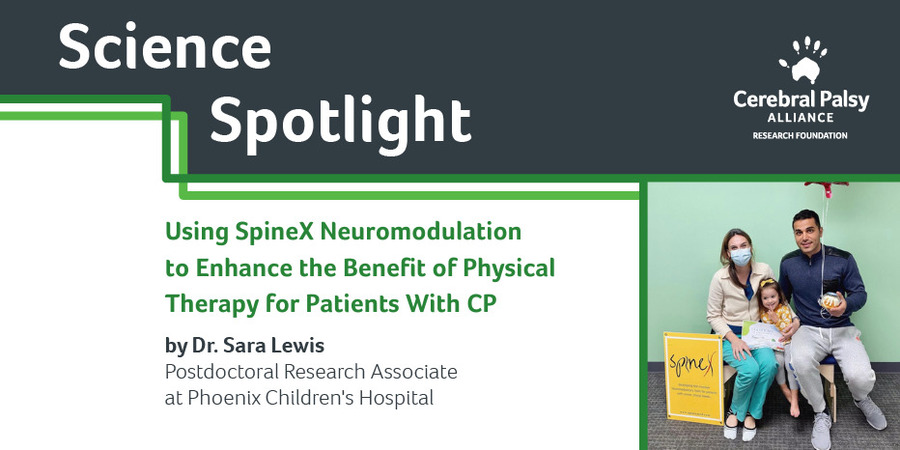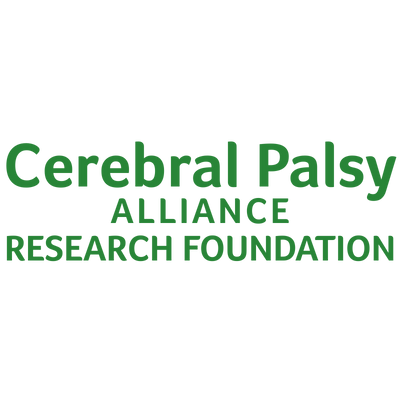
Science Spotlight: Using SpineX Neuromodulation to Enhance the Benefit of Physical Therapy for Patients With CP
By Dr. Sara Lewis
The nervous system can do wondrous things to recover from an injury, and physical therapy (PT) is one of the best tools for improving function for individuals with cerebral palsy (CP). Unfortunately, there can be big differences in how well someone is able to improve with therapies due to numerous factors such as age, extent of injury, and the quality and frequency of PT.
Since PT uses the plasticity — the ability for connections in the body and brain to be remodeled — to improve function, there is interest in boosting the pre-existing mechanisms of plasticity to maximize the potential benefits of PT.
Neuromodulation is a way of tapping the existing plasticity and connections that can use electricity to either activate parts of the nervous system or change their properties. Neurons use electricity to send signals in the brain and body, and electrical stimulation delivered via technologies such as a deep brain stimulation or a pacemaker can regulate abnormal activity to make groups of cells behave more normally.
SpineX has designed a neuromodulation paradigm called Spinal Cord Innovation in Pediatrics (SCiP) for children with CP. Electrical stimulation is applied to the spine, but the amount of electricity is below what’s required to activate muscle activity directly. This may act like amplifying signals that are having a hard time getting through or creating a frequency pattern that suppresses unwanted signals, like using a white noise machine to drown out background noise. This might allow important signals, like the alternating patterns used to drive walking, to work more effectively. If this stimulation is applied during PT, this might improve control of movement and posture to create long-term improvements. In other words, this would train the existing connections to make use of the capabilities that are still intact after an injury.
One of the functions that appear to be intact in CP is proprioception, which is the ability to detect where the body is in space by monitoring joint angle and muscle stretch. Proprioception is critically important in balance, posture, and walking, so it can be beneficial to train the body to use this sense to regulate movements and postures.
During SpineX’s Phase-I pilot study published in 2022, 16 children with CP received eight weeks of therapy with the SpineX neuromodulation. All had clinically significant improvement in their GMFM-88 (motor function) scores. At the beginning of the study, nine children were not able to walk, and some required personal assistance to stay upright and move their limbs for them. After the therapy, five of the nine children who were unable to walk could now take steps with no or minimal assistance. Importantly, these children were able to better practice newly acquired skills outside of PT with active stimulation. This suggests potential long-term benefit.
More studies are needed to confirm this approach can be effective. A Phase-II clinical trial is underway comparing patients receiving the same therapy. Some are receiving neuromodulation and others believe they are receiving stimulation, but the device is off. Comparing these groups is necessary to show that these improvements are due to the stimulation. Collecting long-term data is also crucial to demonstrate that neuromodulation can improve function in a permanent fashion.
Studies with longer treatments and more patients are planned, and Cerebral Palsy Alliance Research Foundation is supporting device and clinical development for SCiP. If the stimulation proves effective in the long term and with many patients, this device can be used to improve the impact of physical therapy for the best outcomes and would represent a successful fusion of new technologies with the tried-and-true methods for improving the lives of people with CP.
Watch this short video featuring Logan, a child with CP who participated in a recent SpineX trial. As a result of her hard work in the trial, she uses her left arm more frequently, she has better balance, she can climb stairs, and she can run. We’re so happy to share her progress!
SpineX is supported by CPARF in this year's Remarkable US accelerator.

References Cited:
https://www.ncbi.nlm.nih.gov/pmc/articles/PMC9535012/
https://clinicaltrials.gov/ct2/show/NCT04882592
Fri 05 Dec 2025
An update on one of our most important initiatives: expanding access to life-changing assistive technology for Native Americans with disabilities.
Fri 10 Oct 2025
We’re thrilled to share an exciting milestone from CPARF’s Changemakers Program — our inaugural community-voted research study has been selected!



